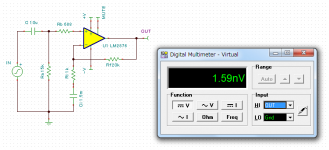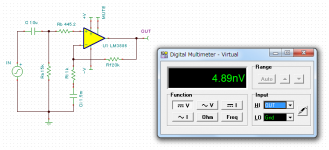I am using TINA-TI version 9.3.200.277 to simulate and help me design an amplifier, and noticed some results that seem inconsistent with what I have read here.
Attached are two test circuits, with most* non-influential components removed for a simpler view. In both, I have adjusted Rb (to a granularity of 0.1Ω) to provide the lowest possible DC offset at the output. (* = Ci is required, and I left Ri in there as well, though neither component's value makes a difference on the readings.)
Three observations from this:
1) Contrary to the webpage above, the lowest DC offset is achieved when the sum of Ra and Rb is a value different than that of Rf.
2) The optimal value for the sum of Ra and Rb differs between the LM2876 and LM3886.
3) The optimal value varies depending on the supply voltages! (Increasing or decreasing the ±24V supplies from ±10% results in an output of ±6.24μV for the LM2876, for example.)
Granted this is simulation, but are these results accurate with real-world implementation?
Admittedly, I do not quite understand how the author achieves balanced bias currents by using equal resistance while input and output voltages differ, but...?
Attached are two test circuits, with most* non-influential components removed for a simpler view. In both, I have adjusted Rb (to a granularity of 0.1Ω) to provide the lowest possible DC offset at the output. (* = Ci is required, and I left Ri in there as well, though neither component's value makes a difference on the readings.)
Three observations from this:
1) Contrary to the webpage above, the lowest DC offset is achieved when the sum of Ra and Rb is a value different than that of Rf.
2) The optimal value for the sum of Ra and Rb differs between the LM2876 and LM3886.
3) The optimal value varies depending on the supply voltages! (Increasing or decreasing the ±24V supplies from ±10% results in an output of ±6.24μV for the LM2876, for example.)
Granted this is simulation, but are these results accurate with real-world implementation?
Admittedly, I do not quite understand how the author achieves balanced bias currents by using equal resistance while input and output voltages differ, but...?

